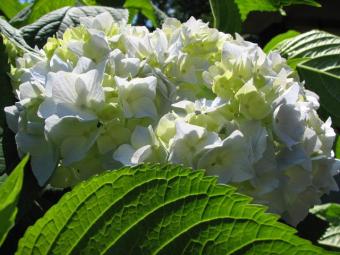
If you live in a state that has warmer winters, then there's a good chance you live in USDA plant hardiness zone 9. Plants that thrive in this zone can handle average low winter temperatures from about 20° to 25°F (Zone 9a) or 25° to 30°F (Zone 9b). Our guide to Zone 9 can help you choose the best plants and plant them at just the right time.
Zone 9 Temperature Range
The temperature of each zone is determined by the average minimum temperature during winter months. The hardiness zones are separated by 10°F. This means that Zone 9 is 10°F colder than Zone 10, and Zone 8 is 10°F colder than Zone 9.
Subset Zone Temperatures (Zone 9a & Zone 9b)
Each zone has two subsets. The Zone 9 subsets are Zone 9a and Zone 9b. Each is separated by 5°F. That means the temperature ranges for Zone 9 are:
- Zone 9: The minimum average temperature range is 20°F to 30°F.
- Zone 9a: The minimum average temperature range is 20°F to 25°F.
- Zone 9b: The minimum average temperature range is 25°F to 30°F.
The hardiness zones are based on minimum average temperatures. However, colder temperatures can occur due to unforeseen weather pattern changes.
List of Zone 9 States

Most states have more than one hardiness zone because of topography and microclimates, which can create pockets of warmer zones in states that otherwise have significantly colder winters. There aren't a ton of states in Zone 9a or Zone 9b. These are states and regions of states that tend to have milder winters. If you're in doubt about your hardiness zone, you can check out the USDA plant hardiness zone map, which lets you search by ZIP code.
| State | Zone | Notes |
|---|---|---|
| Alabama | 9a | Very southeastern tip |
| Arizona | 9a & 9b | Scattered throughout state (see map) |
| California | 9a & 9b | 9a in the east and a few locations throughout state (see map) 9b Central Valley |
| Florida | 9a & 9b | 9a panhandle 9b central |
| Georgia | 9a | South, mostly SE |
| Hawaii | 9a | Big Island (Hawai'i) - center of island (see map) |
| Louisiana | 9a & 9b | 9a central to south 9b extreme south |
| Mississippi | 9a | Extreme south |
| Nevada | 9a & 9b | Extreme southeast (see map) |
| New Mexico | 9a | Very small portion of SE (see map) |
| Oregon | 9a | Southern coastal |
| Texas | 9a & 9b | 9a southeast 9b extreme SE |
Plants That Thrive in Zone 9

Zone 9 is listed as a year-round planting zone, which is ideal for avid gardeners. The generally accepted growing season length for Zone 9 is nine months since the summer months are so hot. Summer heat presents a challenge to typical summer vegetable gardens.
Vegetables That Don't Tolerate High Heat of Zones 9a and 9b
While some hybrids are bred specifically for sweltering heat, many heirlooms and non-hybrid vegetables don't thrive in extreme heat.
- Bell peppers
- Most pole green beans
- Heirloom tomatoes
Best Summer Vegetables for Zone 9
Some heat-loving vegetables thrive during Zone 9's sweltering hot summers. When shopping for seeds or plants, choose heat- and drought-tolerant varieties or hybrids bred to withstand high temperatures.
- Sweet peppers
- Hot peppers
- Sweet potatoes
- Okra
- Eggplant
- Long beans
- Melons
- Legumes
- Heirloom tomatoes including Flamme, Mr Stripey and Pink Ping Pong, Clear Pink Early, and Garden Peach
Fruit & Nut Trees

There are fruit trees, flowers, nut trees, and other plants suitable for Zone 9. These include:
- Citrus trees
- Kiwi
- Passion fruit
- Guava
- Apple
- Fig
- Pear
- Apricot
- Plum
- Pecan
- Black walnut
- Almond
- Hazelnut
Flowers
If you love flowers, you're lucky to live in zone 9. You can grow so many gorgeous flowers.
- Phlox
- Trillium
- Iris
- Lily
- Goldenseal
- Orchid
- Wild ginger
- Black cohosh
- Lily-of-the-valley
- Black-eyed Susans
- Daisies
- Hollyhock
- Rose
- Astilbe
- Foxglove
- Lavender
- Dahlia
Berries
We love a berry, so we're super jealous of Zone 9 folks because of all the berries you can grow.
- Grapes
- Blueberry
- Blackberry
- Strawberry
- Raspberry
- Elderberry
Shrubs
So many gorgeous shrubs grow well in Zone 9.
- Quince
- Magnolia
- Sumac
- Chinese snowball
- Myrtle
- Wisteria
- Hydrangea
- Jasmine
- Hosta
- Forsythia
- Lilac
Frost Dates for Zone 9
All zones have specific timeframes. Zone 9 is unique since the timeframe between the first and last frosts can be less than one to two weeks in January. You can download a current frost date app that allows you to enter your zip code for a current frost timeframe.
Hardiness Zone Designations Omissions
The USDA hardiness zone designations are based solely on temperatures. The guide doesn't include things, such as rainfall, microclimates, soil conditions/fertility, droughts, and unusual weather patterns. All of these can impact the growing process. This information is available in Sunset's The New Western Garden Book.
Zone 9 Gardening Insight
Zone 9 has an extensive growing season that's considered year-round. Using plant guides will ensure you only choose plants that will thrive in your region.







